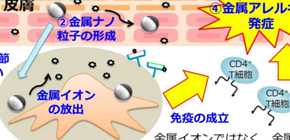
Mouse models for examining the cause of metal allergy established, a world first
Will contribute to the development of prevention and treatment of metal allergy and the development of safe metal nanoparticles
A group of researchers led by then-graduate student HIRAI Toshiro (currently: Researcher, University of Pittsburgh School of Medicine) and Assistant Professor HIGASHISAKA Kazuya, Associate Professor YOSHIOKA Yasuo (currently Specially Appointed Associate Professor), and Professor TSUTSUMI Yasuo at the Graduate School of Pharmaceutical Sciences, Osaka University clarified that metal allergy was not caused by metal ions themselves, but by exposure to metal ions, which formed aggregates/agglomerates inside and outside of the body and ended up with a form similar to metal nanoparticles. This led the team to successfully produce metal allergy mouse models, a world first.
During experiments, mice which had been administered metal nanoparticles or metal ions were once again administered the same metal nanoparticles or metal ions. By measuring exacerbation of inflammatory response, this group investigated the role of metal nanoparticles and metal ions in inducing metal allergy in mice. Later, this group administered nanoparticles or metal ions to the ears of the mice, measuring ear swelling and evaluating the ability to induce the onset of metal allergy of nanoparticles and metal ions.
This group advocated a new mechanism of the onset of metallic allergy based on their findings:
1. Not metal ions, but metal nanoparticles naturally arising from inside and outside of the body can trigger the onset of the allergy.
2. Metal nanoparticles move to the lymph nodes and release metal ions; metal nanoparticles work as a medium of delivering nano ions cause metal allergy.
3. Th17 could be one of the major effector cells in metal allergy.
This group’s achievement is significant not only as basic research on the mechanism behind metal allergy, but also as research on design for optimization of nanoparticles that promotes the development of safe and secure artificial nanoparticles. In other words, designing artificial metal nanoparticles releasing fewer metal ions based on this group’s research results will lead to the development of safer artificial metal nanoparticles that can be ensured to not cause metal allergy.
Abstract
Many people suffer from metal allergy, and the recently demonstrated presence of naturally occurring metal nanoparticles in our environment could present a new candidate for inducing metal allergy. Here, we show that mice pretreated with silver nanoparticles (nAg) and lipopolysaccharides, but not with the silver ions that are thought to cause allergies, developed allergic inflammation in response to the silver. nAg-induced acquired immune responses depended on CD4 + T cells and elicited IL-17A-mediated inflammation, similar to that observed in human metal allergy. Nickel nanoparticles also caused sensitization in the mice, whereas gold and silica nanoparticles, which are minimally ionizable, did not. Quantitative analysis of the silver distribution suggested that small nAg (≤10 nm) transferred to the draining lymph node and released ions more readily than large nAg (>10 nm). These results suggest that metal nanoparticles served as ion carriers to enable metal sensitization. Our data demonstrate a potentially new trigger for metal allergy.
Figure 1
Figure 2
Figure 3
Figure 4
Figure 5
To learn more about this research, please view the full research report entitled “ Metal nanoparticles in the presence of lipopolysaccharides trigger the onset of metal allergy in mice ” at this page of the Nature Nanotechnology website.
Related links

